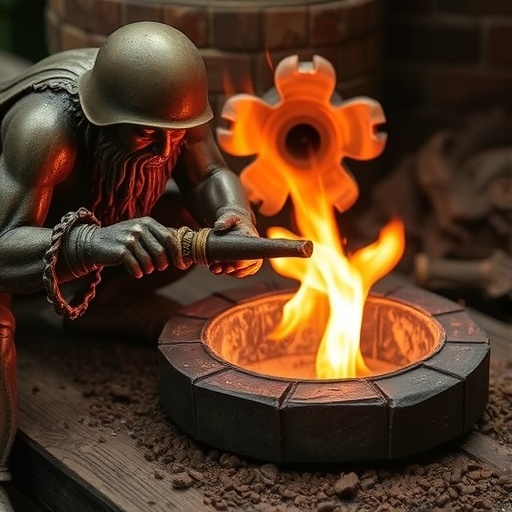Recent archaeological findings in the Domažlice region of Western Bohemia are shedding light on the Bronze Age, particularly through the analysis of casting cakes. These artifacts, once utilized in metal production, serve as significant indicators of the technological and cultural advancements of the time. The study highlights how these casting cakes relate to the Mutěnín copper ore deposit, providing insights into the practices of ancient metalworkers and their connections to local resources.
Casting cakes are essentially the byproducts of metal working, formed during the process of casting molten metal into molds. The significance of these artifacts cannot be overstated; they encapsulate vital information about the methodologies employed in ancient metallurgy. The detailed examination of these relics from the Domažlice region reveals not only the skills and techniques of the artisans but also their socio-economic context within the community.
In comparing the casting cakes from Domažlice to those associated with the Mutěnín copper ore deposit, researchers have established a compelling narrative about resource utilization and trade in the Bronze Age. The Mutěnín deposit, known for its rich copper ores, likely served as a crucial supply point for metal production. This correlation allows archaeologists to draw connections between site-specific metallurgy practices and broader regional trade networks.
The study explores the composition and structure of the casting cakes, employing methods such as scanning electron microscopy and X-ray fluorescence. These techniques reveal the elemental makeup of the cakes, which is critical for understanding the kinds of ores used and the temperatures achieved during the smelting process. Such technical details are vital for reconstructing the technological capabilities of Bronze Age societies.
Moreover, the research addresses the implications of these findings for our understanding of societal organization and labor specialization during the Bronze Age. The presence of specialized metalworking sites indicates a degree of economic complexity and the need for skilled labor. As communities developed these specialized techniques, they laid the groundwork for further advancements, potentially spurring the growth of trade networks across Central Europe.
Additionally, the social dynamics of the time are called into question. The study posits that metalworking may have played a role not just in economic transactions but also in community identity. The production and use of bronze tools and ornaments could have been tied to rituals or status symbols within these ancient societies. Understanding these social aspects can provide a fuller picture of life during the Bronze Age and the interplay between technology and culture.
The historical context of metalworking in Central Europe is rich and multifaceted. As archaeological excavations continue to unearth more evidence, it becomes clear that the technologies and practices of metalworkers were not isolated but were influenced by broader trends across the continent. This interconnectivity is reflected in the composition of metal artifacts found across various sites, hinting at shared techniques and knowledge exchanges among different communities.
As we consider the growing body of research on Bronze Age metallurgy, the significance of local resources cannot be overlooked. The accessibility of copper ores, such as those found at Mutěnín, would have been a determining factor in the development of regional metallurgical practices. These resources shaped not only the technology of metalworking but also the economic landscape of the areas surrounding them.
The role of environmental factors in the production of casting cakes is another area of interest. The study posits that the geological landscape of the Domažlice region provided a unique environment for the development of these metalworking practices. By examining the interplay between resource availability and technological innovation, the research contributes to a deeper understanding of how ancient societies adapted to their surroundings.
Furthermore, the impact of these findings extends beyond the immediate region. As Bronze Age societies facilitated trade, the demand for metal products would have influenced mining and production practices across a wider geographic area. This interconnectedness signifies that the development of metallurgy was not merely a local phenomenon but part of a larger narrative of technological evolution in prehistoric Europe.
In conclusion, the examination of Bronze Age casting cakes from the Domažlice region provides rich insight into the metallurgical practices of ancient societies. The comparison with the Mutěnín copper ore deposit enhances this understanding by situating local activities within a broader historical and geographic context. As researchers continue to analyze these artifacts, the story of Bronze Age metallurgists unfolds further, revealing the complexities of their craft and its implications for social, economic, and cultural development in Central Europe.
Through extensive collaboration and innovative methodologies, the ongoing research in this field is poised to redefine our understanding of the Bronze Age, offering a more nuanced perspective on the lives of those who shaped our metallic past.
Subject of Research: Bronze Age metallurgy and casting practices in the Domažlice region, Central Europe, and their relationship to the Mutěnín copper ore deposit.
Article Title: Bronze age casting cakes from the Domažlice region compared with the Mutěnín copper ore deposit in Western Bohemia (Central Europe).
Article References:
Kmošek, J., Augustýnová, M., Fikrle, M. et al. Bronze age casting cakes from the Domažlice region compared with the Mutěnín copper ore deposit in Western Bohemia (Central Europe).
Archaeol Anthropol Sci 17, 229 (2025). https://doi.org/10.1007/s12520-025-02355-8
Image Credits: AI Generated
DOI: https://doi.org/10.1007/s12520-025-02355-8
Keywords: Bronze Age, metallurgy, casting cakes, Domažlice region, Mutěnín copper ore, Central Europe, archaeological findings, ancient technology, trade networks, social dynamics, environmental factors.




